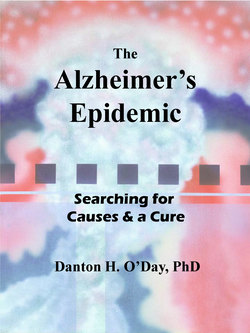Читать книгу The Alzheimer's Epidemic - Danton O'Day - Страница 19
На сайте Литреса книга снята с продажи.
Plaques and Tangles
ОглавлениеHow does this destruction of the Alzheimer’s brain happen? All of our memories are stored in our brains, primarily in the way the nerve cells are interconnected but also via their interactions with other brain cells that are present. (The term “neuron” is more commonly used by scientists as opposed to “nerve cell”.) In certain parts of the brain, the neurons begin to malfunction. If we make a very simple analogy, the brain functions like an electronic device with all sorts of electrical connections. When connections are broken, the device may fail or only be able to perform certain functions. If the neurons in the brain can’t talk to each other or pass along messages in the correct way, then the brain can’t operate correctly. With the progression of the disease, neurons also begin to die. When brain cells no longer communicate with each other, this can lead to their death. This cell death of neurons leads to brain shrinkage and actual “holes” in areas of the brain.
Your next question might be, “How do brain cells fail and die?” Since neurons and other brain cells fail and die in normal brains as well, this is an important question. In fact this cell death is a critical part of normal brain development in utero. In the embryo, millions more brain cells are made than are required. The excess cells are then killed off in an organized way by a process called “programmed cell death” (or, to use the appropriate scientific term, “apoptosis”) that will be discussed later in the book. Brain cells are also killed throughout life. The death of brain cells is important in the building of the connections between them that define how our brain operates. This cell death also removes cells that are not essential for these normal brain functions.
With Alzheimer’s disease, brain cell death is a concern because, unlike normal cell death in brains, it is uncontrolled and it occurs at an alarming rate over an extended period of time. Good brain cells are killed off indiscriminately. For now, we’ll talk in generalities about the two major reasons why this occurs. Both of these reasons involve proteins (Figure 1.4). One of the reasons is the buildup of plaques outside of and between brain cells, a hallmark of Alzheimer’s disease discovered by Alois Alzheimer. These plaques are made up of proteins of which one is the primary culprit. This very small protein culprit is called “amyloid beta”. Actually, since it’s a relatively short sequence of amino acids, it more correctly is called a peptide as detailed in Chapter 6. The amyloid beta peptide is secreted in large amounts by Alzheimer’s neurons but not normal brain cells. Outside the cells, amyloid beta accumulates in plaques, large protein masses that surround brain cells and interfere with their function and survival. As a result, there is a direct correlation between the appearance of the protein in these plaques and the process of neurodegeneration.
Figure 1.4. Protein deposits in the Alzheimer’s brain. Plaques of amyloid beta peptide accumulate outside of brain cells, while neurofibrillary tangles made of tau protein localize inside them.
The second culprit that Alois Alzheimer identified is the fine tangles inside of the neurons of Alzheimer’s brains. Like disorganized tangles of thread, these protein masses work inside of brain cells to negatively alter their function. The protein involved is tau, like the Greek letter. Tau works in normal cells but when large amounts accumulate and it is modified, as we’ll discuss later in Chapter 7, it forms filamentous masses called neurofibrillary tangles.
So you might ask, “If amyloid beta and tau are so bad, why can’t we just prevent their buildup in the brain?” That’s where the story gets a bit more complicated. So we’ll come back to this later in the book. But be aware that tens of thousands of researchers worldwide are trying to figure out just how amyloid beta and tau work and how to stop them from doing what they do.
